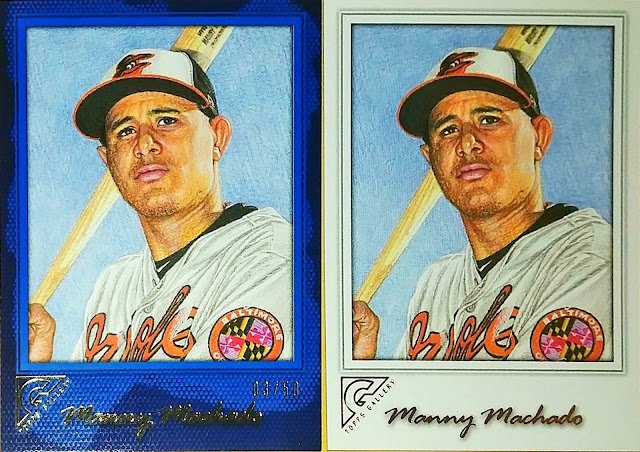A funny thing happens when you're sorting cards. You might discover a card that you hadn't realized existed.
As I work through my Derek Jeter cards -- finally creating a
want list and putting together a definitive list of what I own -- I came across on an error card.
The
1995 Fleer Major League Prospects -- Jeter's first Fleer card -- has two different versions. One has all the correct marking on the back while the other is missing the licensing marks from the bottom of the card.
It's not a significant error nor one that seems to be worth much. There are several of both cards listed on COMC starting at the low, low price of $1.65. Beckett doesn't even list the error, where PSA has it separated out for the master collection.
When looking in my binder, I realized I had the card with no markings. Great, I already had the error card out of the way, so now I needed the correct version of the card. Amazingly, I couldn't find this card in box of Jeter doubles, so next time I'm at a card show, I'll have to look a little more closely at the backs of these cards.
Error cards are interesting because so many people think that just because a card is an error that it's worth more. Generally, it takes two factors for an error card to be valuable:
1. The error card needs to be scarce, because ...
2. There is a corrected version of the card.
With modern cards, error cards usually remain just a widely circulated error. These error cards, usually, carry no premium.
However, there have been famous error cards throughout the years that are very valuable.
1957 Topps Hank Aaron #20
Topps mistakenly used the reverse negative for this card image and Aaron, one of the greatest home run hitters, is pictured as a left-handed hitter.
(These kinds of mistake still happen with players standing in the wrong pose. There are some recent Joey Votto cards where he's pictured with a righty swing when he is in fact a left-handed hitter.)
1987 Donruss Opening Day Barry Bonds #163
On the first print run, Bonds' teammate Johnny Ray is featured instead of the slugger. However, Donruss fixed the mistake on subsequent printings, which makes the error much more valuable. The Ray error card has been sold for hundreds -- if not thousands in a high grade -- while the Bonds rookie sells for far, far less.
1989 Fleer Billy Ripken #616
We all know what is said under the black or white box that Fleer put on different printings. The expletive made it onto some of the cards before it was noticed and the company covered it up. There are several versions of this card with the book value ranging widely on them. The original without any airbrushing is popular, but actually not the most rare. The card with the "white scribble" where it looks like someone tried to write over the bad words sells for the most on the secondary market.
1990 Topps Frank Thomas
Another popular and valuable error card is Frank Thomas' 1990 Topps card that has no name. One of the reasons it became so valuable is because a corrected version in a much higher quantity exists. The no-name version of the card will run collectors hundreds, if not, thousands of dollars.
These days, missing name happen from time-to-time on cards that have the name stamped in foil. Sometimes during the printing process, there will be a run where the foil is missed. When caught, the cards are removed and destroyed, however, a number still make it through.
These won't fetch dollars like the Thomas card. For the most part, the only people who would chase the missing foil cards are probably player collectors looking to have as many different variations of a card that are possible.








































